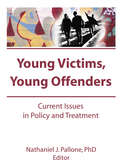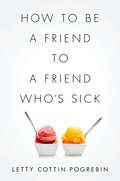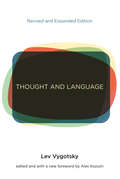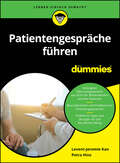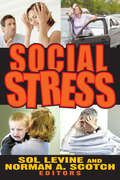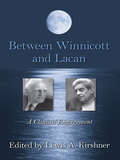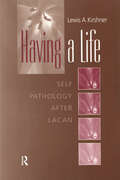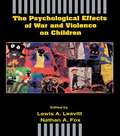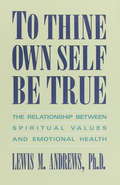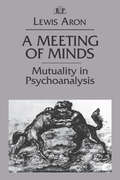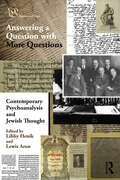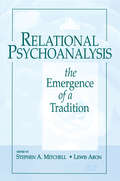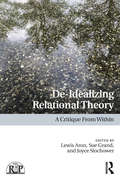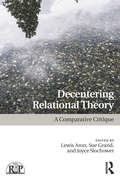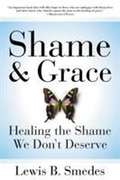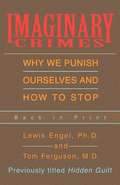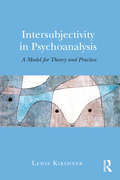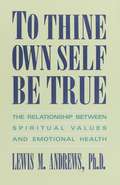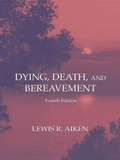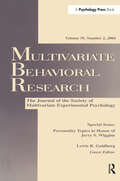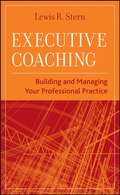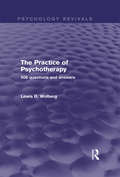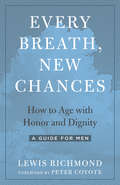- Table View
- List View
Young Victims, Young Offenders: Current Issues in Policy and Treatment
by Letitia C PalloneAt a time when the nation is focused on devising new responses to street crime and on reforming the juvenile justice system, this book brings together in a single volume, current and emerging perspectives on the control of crime by and against children and youth. Young Victims, Young Offenders provides you with an overview of established and emerging practices in treating juvenile offenders and adults who prey on children and youth.This book explores the nature and causes of criminal offenses committed by and against juveniles. While children and youth show up statistically as offenders, they also figure disproportionately as victims. The contributing authors consider both of these aspects as they discuss current programs for the treatment of youths who commit or are victimized by criminal offenses.Topics of a wide range are addressed in Young Victims, Young Offenders for people--like you-- who work with our nation’s youth. A sampling of topics includes: How states address child maltreatment through reporting laws and special courtroom procedures Associations between selected psychosocial variables and chronic delinquency Implications of mandatory Child Abuse Reporting Laws on treating offenders The success of diversion during a 20-year period in a youth service bureau Clinical techniques in the treatment of juvenile sex offenders A study on the effectiveness of an intervention program in Iowa for youthful offendersThis book is useful for the pre-service student pursuing course work in juvenile delinquency, correctional counseling, probation, parole, and social work. At the in-service level, correctional counselors, probation officers, parole officers, social workers, psychologists, psychiatrists, correctional administrators, and child care workers can find much to challenge and enhance their effectiveness in their work with young victims and offenders.
How to Be a Friend to a Friend Who's Sick
by Letty Cottin PogrebinEveryone knows someone whoOCOs sick or suffering. Yet when a friend or relative is under duress many of us feel uncertain about how to cope. Throughout her recent bout with breast cancer, Letty Cottin Pogrebin became fascinated by her friendsOCO and familyOCOs diverse reactions to her and her illness: how awkwardly some of them behaved; how some misspoke or misinterpreted her needs; and how wonderful it was when people read her right. She began talking to her fellow patients and dozens of other veterans of serious illness, seeking to discover what sick people wished their friends knew about how best to comfort, help, and even simply talk to them. Now Pogrebin has distilled their collective stories and opinions into this wide-ranging compendium of pragmatic guidance and usable wisdom. Her advice is always infused with sensitivity, warmth, and humor. It is embedded in candid stories from her own and othersOCO journeys, and their sometimes imperfect interactions with well-meaning friends. "How to Be a Friend to a Friend WhoOCOs Sick" is an invaluable guidebook for anyone hoping to rise to the challenges of this most important and demanding passage of friendship.
Thought and Language, revised and expanded edition
by Lev S. VygotskyA new edition of a foundational work of cognitive science that outlines a theory of the development of specifically human higher mental functions.Since it was introduced to the English-speaking world in 1962, Lev Vygotsky's Thought and Language has become recognized as a classic foundational work of cognitive science. Its 1962 English translation must certainly be considered one of the most important and influential books ever published by the MIT Press. In this highly original exploration of human mental development, Vygotsky analyzes the relationship between words and consciousness, arguing that speech is social in its origins and that only as children develop does it become internalized verbal thought.In 1986, the MIT Press published a new edition of the original translation by Eugenia Hanfmann and Gertrude Vakar, edited by Vygotsky scholar Alex Kozulin, that restored the work's complete text and added materials to help readers better understand Vygotsky's thought. Kozulin also contributed an introductory essay that offered new insight into Vygotsky's life, intellectual milieu, and research methods. This expanded edition offers Vygotsky's text, Kozulin's essay, a subject index, and a new foreword by Kozulin that maps the ever-growing influence of Vygotsky's ideas.
Patientengespräche führen für Dummies (Für Dummies)
by Levent-Jeremie Kan Petra HinzEin unverblümt praxisnahes Handbuch für mehr Verständnis für beide Seiten Verstehen und verstanden werden – nicht selten ein Problem zwischen Behandelnden und Patient. Das kann dieses Buch ändern. Aus verschiedenen Perspektiven stellen Ihnen die Autoren die Ursachen des vielschichtigen Kommunikationsproblems differenziert sowie zielgerichtet vor. In Form von Denkanstößen, Empfehlungen und praktischen Übungen bieten Sie Ihnen auch greifbare Lösungen dazu an. Dabei erklären sie, wie Sie sie erfolgreich auf Ihre individuelle Situation übertragen. In welche Themenschwerpunkte Sie sich hineinarbeiten, welche Ziele Sie sich setzen – all das bleibt Ihnen überlassen. Sie erfahren Was Behandelnder und Patienten jeweils voneinander erwarten Wie Sie Fettnäpfchen und Konflikte vermeiden Welchen Einfluss Ihre Patientengespräche auf Ihren beruflichen Erfolg nehmen
Social Stress
by Levine SolPhysicians are not alone in their concern with stress. Other professionals, such as psychologists and social workers, invoke stress to explain social pathology, for example, alcoholism, suicide, and drug abuse. They are joined by additional individuals in implicating stress in the development of disease. Indeed, conventional wisdom has long noted that to worry, be tense, or take things hard, is to increase one's vulnerability to disease.Sol Levine and Norman A. Scotch argue that whether the focus upon stress is in its origins and its management, or upon its relationship to individual pathology and behavior, it is necessary to appreciate its complexity and its various dimensions. In particular, they discuss and answer the following common questions: To what extent do various work and organizational settings engender stress for various occupants? To what degree does upward and downward social mobility create stress? What are the effects of family disruptions—death, divorce, or desertion—upon the psychological state of the individual?This book presents a clear and comprehensive picture of the phenomena encompassed within the conceptual rubric of stress and to explicate such specific levels or dimensions as the sources of stress, its management, and its consequences. The contributors are top researchers from the fields of sociology, anthropology, psychology, and medicine. They include Sydney H. Croog, Edward Gross, Barbara Snell Dohrenwend, Bruce P. Dohrenwend, Richard S. Lazarus, Andrew Crider, John Cassell, E. Gartly Jaco, James E. Teele, Robert Scott, and Alan Howard. The work concludes with a statement by the editors summarizing the data and themes that are presented throughout the work. This work should be read by all individuals. In particular, it will be invaluable for sociologists, psychologists, and professional social scientists.
Between Winnicott and Lacan: A Clinical Engagement
by Lewis A. KirshnerD. W. Winnicott and Jacques Lacan, two of the most innovative and important psychoanalytic theorists since Freud, are also seemingly the most incompatible. And yet, in different ways, both men emphasized the psychic process of becoming a subject or of developing a separate self, and both believed in the possibility of a creative reworking or new beginning for the person seeking psychoanalytic help. The possibility of working between their contrasting perspectives on a central issue for psychoanalysis - the nature of the human subject and how it can be approached in analytic work - is explored in this book. Their differences are critically evaluated, with an eye toward constructing a more effective psychoanalytic practice that takes both relational and structural-linguistic aspects of subjectivity into account. The contributors address the Winnicott-Lacan relationship itself and the evolution of their ideas, and provide detailed examples of how they have been utilized in psychoanalytic work with patients. Contributors: Jeanne Wolff Bernstein, James Gorney, Andre Green, Mardi Ireland, Lewis Kirshner, Deborah Luepnitz, Mari Ruti, Alain Vanier, Francois Villa .
Having A Life: Self Pathology after Lacan
by Lewis A. KirshnerWhat is it about "having a life"- which is to say, about having a sense of separate existence as a subject or self - that is usually taken for granted but is so fragilely maintained in certain patients and, indeed, in most of us at especially difficult times? In Having A Life: Self Pathology After Lacan, Lewis Kirshner takes this Lacanian question as the point of departure for a thoughtful meditation on the conceptual problems and clinical manifestations of pathologies of the self. Beginning with the case of Margaret Little, analyzed by D. W. Winnicott, and proceeding to extended case presentations from his own practice, Kirshner weaves together an avowedly American reading of Lacan with the approaches to self pathology of an influential coterie of theorists. By drawing out common threads in their respective discourses on the self, Kirshner achieves an original integration of Lacanian theory with other contemporary approaches to self pathology. Of special note is his ability to sustain a dialogue between Lacan and Kohut, whose shared clinical object, discernible through divergent vocabularies and conceptions, is the struggle of the subject to avoid fragmentation that would obliterate a sense of aliveness and preclude active engagement with the world. Kirshner's opening chapter on the gifted, troubled Margaret Little and his concluding chapter on the eminent political philosopher Louis Althusser, whose self pathology culminated in his strangling of his wife, Hélène Rytman, in 1980, frame a study that is brilliantly successful in bringing "self" issues down to the messy actualities of lived experience. Analytic therapists no less than students of the human sciences will be edified by this cogent, readable attempt to infuse Lacanian concepts with the conceptual rigor and clinical pragmatism of American psychoanalysis and to apply the resulting model of therapeutic action to a fascinating range of case material.
The Psychological Effects of War and Violence on Children
by Nathan A. Fox Lewis A. LeavittThe outgrowth of a conference planned as a response to the need for researchers and clinicians to develop integrated plans for addressing the psychological trauma of children exposed to violence, this volume's goals are: * to summarize research on the subject with particular emphasis on the Gulf War; * to use this information to formulate an outline of what current knowledge suggests are reasonable approaches to public mental health intervention; and * to develop an agenda for future research necessary for improving clinical efforts in varying international conflicts. A significant collection of diverse perspectives attending to a diversity of cultural and political contexts, the contributors offer many conclusions about important dimensions for analyzing the effects of violence on children. Suggesting informed approaches to public mental health efforts which can be implemented, the work presented here directs attention to the need for interdisciplinary collaboration among researchers and clinicians to better understand the effects of exposure to violence on the psychological well being of children and the optimal modes of remediation on individual, family, and community levels.
To Thine Own Self Be True
by Lewis AndrewsA seminal work on ethical therapy and the vital connection between responsibility, personal values, and peace of mind. "One of the most valuable, enlightening books I have ever read. " -- Hugh Prather
A Meeting of Minds: Mutuality in Psychoanalysis (Relational Perspectives Book Series #4)
by Lewis AronIn this richly nuanced assessment of the various dimensions of mutuality in psychoanalysis, Aron shows that the relational approach to psychoanalysis is a powerful guide to issues of technique and therapeutic strategy. From his reappraisal of the concepts of interaction and enactment, to his examination of the issue of analyst self-disclosure, to his concluding remarks on the relational import of the analyst's ethics and values, Aron squarely accepts the clinical responsibilities attendant to a postmodern critique of psychoanalytic foundations.
Contemporary Psychoanalysis and Jewish Thought: Answering a Question with More Questions (Psyche and Soul)
by Lewis Aron Libby HenikDemonstrating the connections between contemporary psychoanalysis, Jewish thought and Jewish history, this volume is a significant contribution to the traditions of dialogue, debate and change-within-continuity that epitomize these disciplines. The authors of this volume explore the cross-disciplinary connections between psychoanalysis and Jewish thought, while seeking out the resonance of new meanings, to exemplify the uncanny similarities that exist between ancient Rabbinic methods of interpretation and contemporary psychoanalytic theory and methodology, particularly the centrality of the question and the deconstruction of narrative. In doing so, this collaboration addresses the bi-directional influence between, and the relevance of, the Jewish interpretive tradition and psychoanalysis to provide readers with renewed insight into key topics such as Biblical text and midrash, religious traditions, trauma, gender, history, clinical work and the legacies of the Holocaust on psychoanalytic theory. Creating an intimate environment for interdisciplinary dialogue, this is an essential book for students, scholars and clinicians alike, who seek to understand the continued significance of the multiple connections between psychoanalysis and Jewish thought.
Relational Psychoanalysis, Volume 14: The Emergence of a Tradition (Relational Perspectives Book Series #14)
by Stephen A. Mitchell Lewis AronOver the course of the past 15 years, there has been a vast sea change in American psychoanalysis. It takes the form of a broad movement away from classical psychoanalytic theorizing grounded in Freud's drive theory toward models of mind and development grounded in object relations concepts. In clinical practice, there has been a corresponding movement away from the classical principles of neutrality, abstinence and anonymity toward an interactive vision of the analytic situation that places the analytic relationship, with its powerful, reciprocal affective currents, in the foreground. These developments have been evident in virtually all schools of psychoanalysis in America, from the most traditional to the most radical. The wellspring of these innovations is the work of a group of psychoanalysts who have struggled to integrate aspects of interpersonal psychoanalysis, various British object relations theories, and psychoanalytic feminism. Although not self-selected as a school, these theorists have generated a distinct tradition of psychoanalytic thought and clinical practice that has become extremely influential within psychoanalysis in the United States. Relational Psychoanalysis: The Emergence of a Tradition brings together for the first time the seminal papers of the major authors within this tradition. Each paper is accompanied by an introduction, in which the editors place it in its historical context, and a new afterward, in which the author suggests subsequent developments in his or her thinking. This book is an invaluable resource for any clinical practitioner, teacher or student of psychoanalysis interested in exploring the exciting developments of recent years.
De-Idealizing Relational Theory: A Critique From Within (Relational Perspectives Book Series)
by Lewis Aron, Sue Grand, and Joyce SlochowerSelf-examination and self-critique: for psychoanalytic patients, this is the conduit to growth. Yet within the field, psychoanalysts haven’t sufficiently utilized their own methodology or subjected their own preferred approaches to systematic and critical self-examination. Across theoretical divides, psychoanalytic writers and clinicians have too often responded to criticism with defensiveness rather than reflectivity. De-Idealizing Relational Theory attempts to rectify this for the relational field. This book is a first in the history of psychoanalysis; it takes internal dissension and difference seriously rather than defensively. Rather than saying that the other’s reading of relational theory is wrong, distorted, or a misrepresentation, this book is interested in querying how theory lends itself to such characterizations. How have psychoanalysts participated in conveying this portrayal to their critics? Might this dissension illuminate blind-spot(s) and highlight new areas of growth? It's a challenge to engage in psychoanalytic self-critique. To do so requires that we move beyond our own assumptions and deeply held beliefs about what moves the treatment process and how we can best function within it. To step aside from ourselves, to question the assumed, to take the critiques of others seriously, demands more than an absence of defensiveness. It requires that we step into the shoes of the psychoanalytic Other and suspend not only our theories, but our emotional investment in them. There are a range of ways in which our authors took up that challenge. Some revisted the assumptions that underlay early relational thinking and expanded their sources (Greenberg & Aron). Some took up specific aspects of relational technique and unpacked their roots and evolution (Mark, Cooper). Some offered an expanded view of what constitutes relational theory and technique (Seligman, Corbett, Grossmark). Some more directly critiqued aspects of relational theory and technique (Berman, Stern). And some took on a broader critique of relational theory or technique (Layton, Slochower). Unsurprisingly, no single essay examined the totality of relational thinking, its theoretical and clinical implications. This task would be herculean both practically and psychologically. We're all invested in aspects of what we think and what we do; at best, we examine some, but never all of our assumptions and ideas. We recognize, retrospectively, how very challenging a task this was; it asked writers to engage in what we might think of as a self-analysis of the countertransference. Taken together these essays represent a significant effort at self-critique and we are enormously proud of it. Each chapter critically assesses and examines aspects of relational theory and technique, considers its current state and its relations to other psychoanalytic approaches. De-Idealizing Relational Theory will appeal to all relational psychoanalysts and psychoanalytic psychotherapists.
Decentering Relational Theory: A Comparative Critique (Relational Perspectives Book Series)
by Lewis Aron, Sue Grand, and Joyce SlochowerDecentering Relational Theory: A Comparative Critique invites relational theorists to contemplate the influence, overlaps, and relationship between relational theory and other perspectives. Self-critique was the focus of De-Idealizing Relational Theory. Decentering Relational Theory pushes critique in a different direction by explicitly engaging the questions of theoretical and clinical overlap – and lack thereof – with writers from other psychoanalytic orientations. In part, this comparison involves critique, but in part, it does not. It addresses issues of influence, both bidirectional and unidimensional. Our authors took up this challenge in different ways. Like our authors in De-Idealizing, writers who contributed to Decentering were asked to move beyond their own perspective without stereotyping alternate perspectives. Instead, they seek to expand our understanding of the convergences and divergences between different relational perspectives and those of other theories. Whether to locate relational thought in a broader theoretical envelope, make links to other theories, address critiques leveled at us, or push relational thinking forward, our contributors thought outside the box. The kinds of comparisons they were asked to make were challenging. We are grateful to them for having taken up this challenge. Decentering Relational Theory: A Comparative Critique will appeal to psychoanalysts and psychoanalytic psychotherapists across the theoretical spectrum.
Shame and Grace: Healing the Shame We Don't Deserve
by Lewis B. SmedesA Proven Path to Move from Shame to Healing. If you persistently feel you don't measure up, you are feeling shame--that vague, undefined heaviness that presses on our spirit, dampens our gratitude for the goodness of life, and diminishes our joy. The good news is that shame can be healed. With warmth and wit, Lewis B. Smedes examines why and how we feel shame, and presents a profound, spiritual plan for healing. Step by step, Smedes outlines the road to well-being and the peace that comes from knowing we are accepted by the grace of One whose acceptance of us matters most.
Imaginary Crimes: Why We Punish Ourselves and How to Stop
by Tom Ferguson Lewis EngelThis liberating book shows us how to break out of the self-defeating patterns that have been keeping us from attaining our most cherished goals.
Intersubjectivity in Psychoanalysis: A Model for Theory and Practice
by Lewis KirshnerIn this book, Lewis Kirshner explains and illustrates the concept of intersubjectivity and its application to psychoanalysis. By drawing on findings from neuroscience, infant research, cognitive psychology, Lacanian theory, and philosophy, Kirshner argues that the analytic relationship is best understood as a dialogic exchange of signs between two subjects—a semiotic process. Both subjects bring to the interaction a history and a set of unconscious desires, which inflect their responses. In order to work most effectively with patients, analysts must attend closely to the actual content of the exchange, rather than focusing on imagined contents of the patient's mind. The current situation revives a history that is shaped by the analyst's participation. Supported by numerous case studies, Intersubjectivity in Psychoanalysis: A Model for Theory and Practice is a valuable resource for psychotherapists and analysts seeking to refine their clinical goals and methods.
To Thine Own Self Be True: The Relationship Between Spiritual Values and Emotional Health
by Lewis M. Andrews"There is a newfound confidence and enthusiasm for living. But perhaps the most remarkable development of all is the recognition that this spiritual therapy is not really a new discovery, revealed by some outside authority, as much as it is a reminder of the basic truths we have always known in our own hearts. In healing ourselves, we learn that the greatest wisdom of all lies not in listening to others but in being true to our deepest selves".
Experimental Child Psychologist: Essays and Experiments in Honor of Charles C. Spiker
by Lewis P. Lipsitt and Joan H. CantorFirst Published in 1986. Routledge is an imprint of Taylor & Francis, an informa company.
Dying, Death, and Bereavement
by Lewis R. AikenThis book is a brief but comprehensive survey of research, writings, and professional practices concerned with death and dying. It is interdisciplinary and eclectic--medical, psychological, religious, philosophical, artistic, demographics, bereavement, and widowhood are all considered--but with an emphasis on psychological aspects. A variety of viewpoints and research findings on topics subsumed under "thanatology" receive thorough consideration. Questions, activities, and projects at the end of each chapter enhance reflection and personalize the material. This fourth edition features material on: * moral issues and court cases concerned with abortion and euthanasia; * the widespread problem of AIDS and other deadly diseases; * the tragedies occasioned by epidemics, starvation, and war; and * the resumption of capital punishment in many states. The book's enhanced multicultural tone reflects the increased economic, social, and physical interdependency among the nations of the world. Topics receiving increased attention in the fourth edition are: terror management; attitudes and practices concerning death; cross-cultural concepts of afterlife; gallows humor, out-of-body experiences; spiritualism; mass suicide; pet and romantic death; euthanasia; right to die; postbereavement depression; firearm deaths in children; children's understanding of death; child, adolescent, adult, and physician-assisted suicide; religious customs and death; confronting death; legal issues in death, dying and bereavement; death education; death music; creativity and death; longevity; broken heart phenomenon; beliefs in life after death; new definitions of death; children's acceptance of a parent's death; terminal illness; and the politics of death and dying.
Human Differences
by Lewis R. AikenThis text reviews the mass of information concerning the ways in which individuals and groups differ from each other. Reviews of research findings and interpretations are provided on: physical appearance, performance and health; cognitive abilities; personality; and development across the life span. Extensive treatment of foundations (historical, measurement, research methods, biological, social, and cultural) is also provided. Both normal and abnormal behaviors are considered. The book provides an interdisciplinary focus, including material from all the behavior and natural sciences, not just psychology, sociology, or biology.
Personality Topics in Honor of Jerry S. Wiggins: A Special Issue of Multivariate Behavioral Research
by Lewis R. GoldbergFirst published in 2004. Routledge is an imprint of Taylor & Francis, an informa company.
Executive Coaching
by Lewis R. SternUnderstand all the aspects of becoming an executive coach, from acquiring training to marketing your practice, with Executive Coaching: Building and Managing Your Professional Practice. Hands-on information on topics like acquiring the right training and making the transition from other fields is written in an accessible manner by a successful and experienced coach. Whether you're a novice or an established coach looking to expand your practice, you will benefit from the step-by-step plan for setting up and operating a lucrative executive coaching practice.
The Practice of Psychotherapy: 506 Questions and Answers (Psychology Revivals)
by Lewis R. WolbergFreud once humorously remarked that "Anyone who wants to make a living from the treatment of nervous patients must clearly be able to do something to help them". It is amazing how frequently this simple precept is ignored and, when a patient does not get well, how often the failure is attributed to lack of proper motivation, diminutive ego strength, latent schizophrenia, and a multitude of assorted resistances. Difficulties that arise during therapy are not due to a deliberate conspiracy of neglect on the part of the therapist. They usually come about because of obstructive situations that develop in work with patients with which the therapist is unprepared to cope. During his psychiatric career the author, who spent time both teaching and supervising, collected and collated questions from students and graduate therapists who had raised concerns about psychotherapy that related to such obstructive situations. Originally published in 1982, this volume contains both those questions and his answers.
Every Breath, New Chances: How to Age with Honor and Dignity--A Guide for Men
by Lewis RichmondTools and anecdotes to reframe aging from the bestselling author of Work as a Spiritual Practice and Aging as a Spiritual Practice.Aging is a journey: a decades-long adventure of new opportunities and surprises. For many men, the decline in virility and power that accompanies age can be a tough pill to swallow. When these fall away, how do we make sense of who we are? What does it mean to be a man?Drawing from research, interviews, and personal stories, Every Breath, New Chances shows readers how to turn toward the changes associated with aging and to reevaluate losses and transitions as new avenues for joy, self-discovery, renewal, and growth. Delving into topics such as divorce, single living, retirement, and encore careers, each chapter includes a contemplative practice called Deep Mind Reflection to help readers navigate the fears and aspirations that come along with changes in relationships and work. This book addresses the more challenging realities associated with illness, substance abuse, and mortality, while empowering readers to compassionately embrace next steps and spiritual preparations for their final decades of life. This book does not proffer tools for staving off an inevitable part of life; rather, it offers frameworks and strategies for peacefully embracing it.
